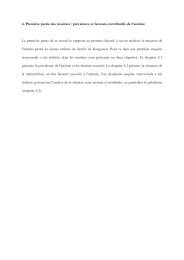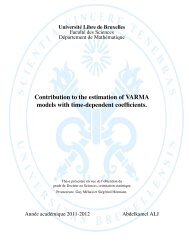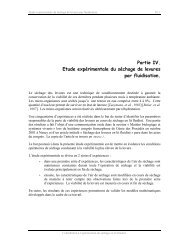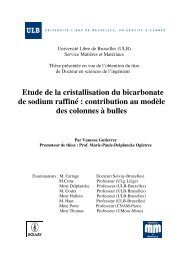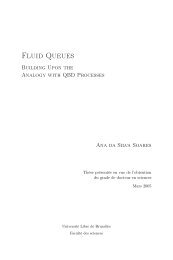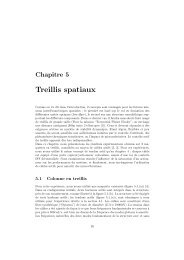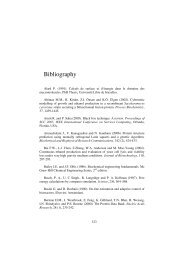Diapositive 1 - de l'Université libre de Bruxelles
Diapositive 1 - de l'Université libre de Bruxelles
Diapositive 1 - de l'Université libre de Bruxelles
Create successful ePaper yourself
Turn your PDF publications into a flip-book with our unique Google optimized e-Paper software.
Chapitre IIITemperature and salinity effects on Sr/Ca ratioThe Sr/Ca ratio in the skeleton of A. rubens grown in experimental conditions <strong>de</strong>pen<strong>de</strong>don both temperature and salinity. Higher Sr/Ca ratios were recor<strong>de</strong>d at lower temperature.This is consistent with field results in a sand dollar, where a linear inverse relationbetween Sr/Ca ratio and temperature of the collection site was documented (Pilkey &Hower 1960). This relation is unusual for biogenic calcites in which Sr/Ca ratios areeither unrelated or positively linked to temperature (e.g., De Deckker et al 1999, Lea et al1999, Stoll et al 2002). Wasylenki et al (2005) showed that Sr incorporation into abioticcalcite increased with supersaturation. However, supersaturation in seawater increaseswith temperature (Morse & Mackenzie 1990). Supersaturation level in the calcifyingvacuole is unknown, but metabolism increases with temperature and a higher iontransport is expected. To our knowledge, Sr incorporation in ACC has never beeninvestigated. Such a study, including possible interactions and/or competition with Mg,could provi<strong>de</strong> a first insight in the mechanisms of Sr/temperature relationships in theechino<strong>de</strong>rm skeleton. The thermodynamics of the process should be worth investigating(Sr incorporation in the aragonite lattice is exothermic and responsible for the inverserelation between Sr concentration and temperature in aragonitic minerals).The Sr/Ca ratios in the starfish skeleton increased with salinity. This relation cannot beexplained by kinetic factors, as growth rate had no influence on the skeletal Sr/Ca ratio.Furthermore, because the seawater Sr/Ca ratio remains constant between 10 and 35 psu(Dodd & Crisp 1982, Ingram et al 1998, Shen et al 1996), the variation of skeletal Sr/Caratio cannot be the result of variation in seawater Sr/Ca ratios. A metabolic effect due tosalinity can be proposed, as the one <strong>de</strong>duced for Mytilus trossulus by Klein et al (1996).In these mussels, intracellular transport of shell-forming inorganic components fromseawater to the site of mineralization dominated intercellular transport. As intracellulartransport is more Ca specific than intercellular transport, Ca concentration will becontrolled and Sr concentration will <strong>de</strong>crease in response to a salinity <strong>de</strong>crease. Theskeletal Sr/Ca ratio will then <strong>de</strong>crease with salinity. It is interesting that, for echino<strong>de</strong>rms,Ca has also been reported to be controlled in echino<strong>de</strong>rm inner fluids (see Binyon 1962,Stickle & Diehl 1987), while Sr was not.72



